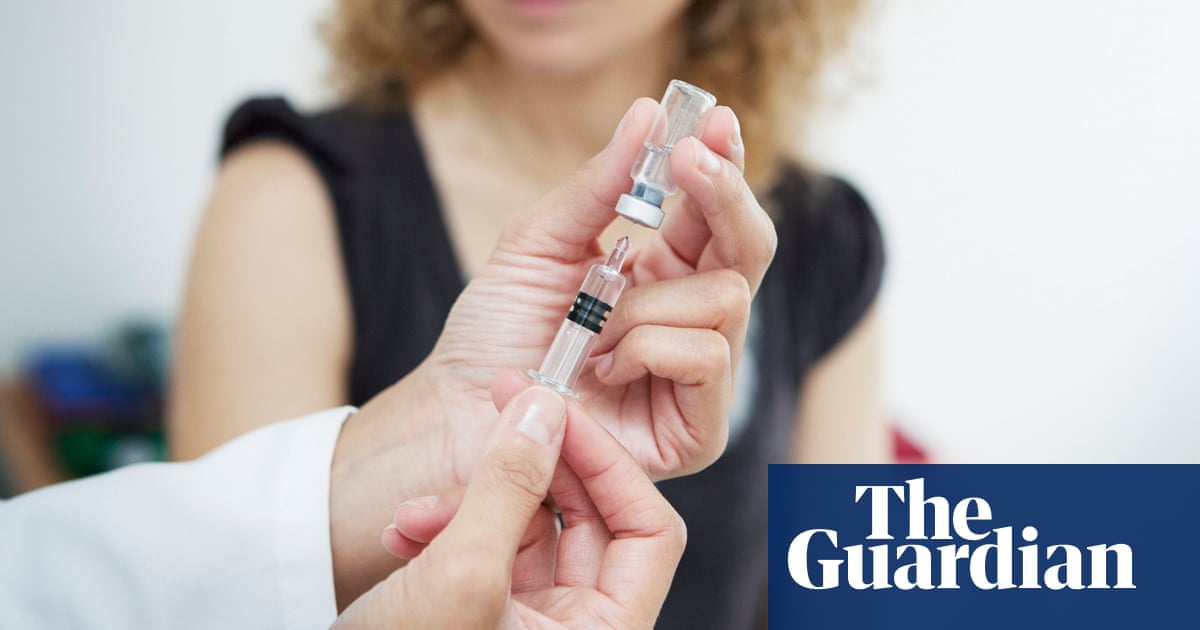Immunisation rates are lagging in Australia’s most vulnerable populations – the very young and old – with experts blaming practical barriers as well as the misinformation and vaccine hesitancy that took off during the Covid-19 pandemic.
In 2020 Australia achieved a record high rate of 95.09% five-year-olds fully immunised against infectious diseases, even surpassing the government’s target of 95%, which provides “herd immunity”.
Between the ages of two months and five years, Australian children are supposed to receive vaccines against viruses including hepatitis B, diphtheria, whooping cough, meningococcal, polio, mumps, measles and rubella.
However, the latest government data shows Australian children have fallen below that target, with only 93.93% of five-year-olds who have had all vaccines recommended for their age, 91.24% of two-year-olds and 93.16% of one-year-olds.
The government’s data breaking down rates by primary health network also shows certain areas have consistently lower rates. New South Wales’s north coast, Queensland’s Gold Coast and country Western Australia’s rates are all below 90% for one- and two-year-olds. Vaccination rates for five-year-olds in the Gold Coast and country WA were above 90%, but not among children of that age in NSW’s north coast.
For the coastal Richmond Valley area within the North Coast Primary Health Network, immunisation rates are below 80% in the youngest age groups.
A new study of more than 3,000 Australian parents published in the Medical Journal of Australia found misinformation and vaccine hesitancy increased during the pandemic compared with the views of research participants in 2017.
But it also noted that practical barriers, such as disruption to routine vaccination services, was also a factor in decreasing childhood vaccination rates.
Vaccination rates are also lagging in older populations not up to date on Covid and flu boosters during a winter wave of Covid-19 and other respiratory viruses.
The most recent federal government data released in May shows only 40% of those over 75 are up to date in receiving their booster shot in the past six months, while only 25% of those aged 65-74 and only 4% of adults under 65 have received a booster shot in the past six months.
Only 74% of aged care residents have received a booster dose since the beginning of last year.
The government’s advisory group for immunisation updated its guidelines in May recommending a booster dose every 12 months for Australians aged between 18 and 74, who are also eligible for a booster every six months, while those over 75 are recommended to receive a booster every six months.
after newsletter promotion
Prof Adrian Esterman, the chair of biostatistics and epidemiology at the University of South Australia, said Covid-19 has encouraged vaccine hesitancy.
“I think the general thrust of what we’re seeing is that Covid has put a spanner in the works,” he said. “It’s basically made a lot of people scared of getting vaccinated – not only adults but of getting their kids vaccinated – because of all the hype about how dangerous vaccines are.
“The actual number of severe adverse events is minuscule compared to the millions and millions of doses given out.”
Prof Robert Booy, an infectious diseases paediatrician, said the overall drop in vaccination rates among children was “not a lot but it’s important”.
“We need to re-establish the strong trust we’ve always had for a long time with the Australian public about the safety and effectiveness of vaccination in children and adults,” he said.
Prof Peter McIntyre, the head of women’s and children’s health at the University of Otago’s school of medicine, and a former director of Australia’s National Centre for Immunisation Research and Surveillance, said he believed vaccine hesitancy due to the pandemic was part of the picture but should not be overstated.
“The number of people who are not vaccinated because they are actively avoiding vaccine is still a small percentage,” he said. “It’s probably only about 3% – maybe it’s kicked up a little bit post-Covid.”
McIntyre said the most common reason people were not vaccinated and had not immunised their children was due to service barriers.
He said there needed to be greater opportunities for accessing vaccination outside of appointments with GPs, who could often be difficult to get an appointment with, such as accessing vaccines through pharmacists or offering home-visit services.
McIntyre said Australia should consider requiring children to be vaccinated to attend school or childcare, as occurs in the US. There were recommendations for schoolchildren in Australia to be vaccinated but it was not enforced, he said.
Prof Julie Leask, a vaccine expert at the University of Sydney, said lagging vaccination rates were the result of issues including access to services and vaccine acceptance.
Leask said the disparity in rates between areas often demonstrated inequity in access to services where there is more poverty and social exclusion.
“There’s been a big focus on vaccine refusal and misinformation as if there’s this direct and linear impact,” Leask said. “People can reject vaccination because of negative experiences with healthcare and due to certain beliefs and values.”







